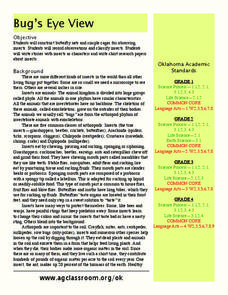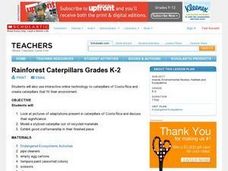Curated OER
Conservation in Small Spaces: Butterfly Life cycles
Students discuss ways that butterflies and moths change during their lifecycles, observe caterpillars, and explore how their different body parts work.
Curated OER
Butterflies are beautiful
Second graders explore butterflies. They discuss the types of butterflies that are found in Indiana. Students learn what kind of plants are needed to start a butterfly garden. They study the four life stages of a butterfly.
Curated OER
A Moth Is Not a Butterfly!
Students identify the differences and similarities between a butterfly and a moth. They complete a Venn diagram, participate in class discussion and conduct related Internet research on the topic.
Curated OER
Caterpillars To Butterflies
Students observe the life cycle of a butterfly. They read butterfly/caterpillar themed books. They sequence the lifecycle from eggs on a leaf to an adult butterfly. They release their butterflies into a natural habitat after singing and...
Curated OER
Life Cycle of the Monarch Butterfly
Third graders access prior knowledge of the monarch butterfly and discuss what they would like to know. In this Monarch Butterfly lesson,students read Monarch Butterfly and discuss the life cycle of the butterfly. Students gather...
Curated OER
Caterpillars To Butterflies
Students gain an appreciation of nature by teaching them about the life cycle of the butterfly. They set up a terrarium so they can observe the changes a caterpillar goes through.
Curated OER
Classroom Animals & Pets - Insects & Company - Butterflies
Young scholars examine the life cycle of a butterfly. They place caterpillars in a cage and observe their change to a butterfly. Students discover how much a caterpillar eats and annotate growth information.
Curated OER
Pollination of Flowers by Moths
Turn your classroom into a pollination station as your kids transform into moths or predators trying to survive and aiding in plant reproduction along the way. Using silent party blowers as proboscises, the moths will have two minutes to...
Curated OER
Life Cycle
Young scientists explore the world of entomology. They focus on the life cycle of butterflies and moths. They utilize the entire school year in order to see how butterfly eggs turn into the chrysallis, then into a butterfly, who then...
Curated OER
Butterfly/Moth Poster
Students learn how to identify which species of dragonflies or butterflies are found in their County by learning to read the Odonata or Lepidoptera checklist to find the scientific names; they also search field guides and the Internet...
Curated OER
What Is An Insect?
Young scholars find and classify insects. They collect insects, study them with a hand lens and identify its body parts. Afterwards, they discus various types of insects and thier Orders such as beetles, butterflies and moths,...
Curated OER
A Lovely Captive
Fourth graders construct a habitat which allows them to observe the metamorphosis of a caterpillar into a butterfly. They place a plate on the bottom of the cylinder to serve as a landing platform. They use the cage for keeping adult...
Curated OER
Insects
Third graders research an insect and creates a brochure on that selected insect. Each student develops a Venn Diagram comparing similarities and differences between moths and butterflies.
Curated OER
How does Temperature Affect Time in the Pupa Stage?
High schoolers are guided through the Scientific Method to perform observations about the pupa stage of the monarch butterfly. The results of an experiment are used to make assumptions about growth and development.
Curated OER
Symbiosis and Co-evolution
By choosing a species and researching an adaptive symbiotic relationship it shares with another species, your students are able to investigate a symbiotic relationship in a lab setting. They create a presentation using a variety of...
Curated OER
Insects
Students observe and identify insects in their local. They record their observations by drawing a picture of the insect and writing a description.
Curated OER
The Greatest Show on Earth: The World's Smallest Animals
Students create instruments to capture different types of insects. In this The Greatest Show on Earth: The World's Smallest Animals lesson, students compare the attributes of certain insects and record the data on a chart. After catching...
Curated OER
Arthropod Mouth Parts and Food
Students identify the different types of mouths arthropods have for eating various types of food. Given photographs of the different types of arthropods, students identify which mouth they have and what type of food they can eat with...
Curated OER
Bug's Eye View
Learners explore biology by writing fictitious stories in class. In this insect life lesson, students identify many different types of insects in the animal kingdom and the classifications they fall into. Learners collect insects on a...
Curated OER
Magnificent Metamorphosis
Learners discover stages in metamorphosis through up close and real encounters with video, hands-on investigative and interactive activities using mealworms.
Curated OER
Development in Drosophila melanogaster
Learners study the least familiar aspect of development in Drosophila melanogaster; the development of the pupa. Students isolate and culture "First-day" pupae. They are dissected daily to study the progressive developmental changes.
Curated OER
Rainforest Caterpillars Grades K-2
Learners are told that after they discuss and examine of rainforest caterpillars, they are going to create their own rainforest caterpillar based on the information they have studied. They are given the habitat scenarios on 3x5 cards.
Curated OER
Meadow Study
Students examine insects they collect in a sweep nets. They identify as many of the insects as they can.
Other popular searches
- Butterflies Moths Life Cycle
- Butterflies & Moths Helpful
- Moths and Butterflies
- Butterflies Moths Poem
- Butterflies and Moths Book
- Butterflies and Moths Essay






















